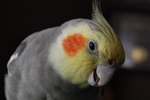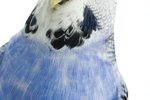
Parakeets let it be known when they don't like another. They flap and squawk, fly to opposite corners of a space and may even peck at each other. But beyond the absence of these negative behaviors, clear positive signs reveal when parakeets really are fond of one another.
Sitting Together
Parakeet pals often like to sit near each other. If they are in separate cages, which is recommended at first so they can get used to each other in proximity without being in one another's space, they will tend to sit as close to one another as they can, within their individual cages. If you bring them to a single cage later, they may hesitate at first, but will ultimately sit next to each other, on the same perch, close enough to touch, if they like each other.
Preening Each Other
Parakeets preen many times during the day, taking oil from the glands on their backs and and spreading it down each feather with their beaks. This keeps the feathers groomed and protects them from water and cold. Parakeets in a flock or together in cages will usually preen at the same time. If they like each other, they'll reach over and preen each other, especially their heads, which are impossible to reach on oneself. Parakeets don't have to be mates to do this; even pals will preen each other.
Scratching Heads
Every animal gets an itchy scalp sometimes, including parakeets. Single parakeets will rub their heads on their perches, cages or other suitable fixtures, but the parakeet who's lucky enough to have a buddy may scratch the buddy's head with his beak, and the buddy will return the favor.
Feeding Habits
Parakeets who have bonded will often eat together, going for food at the same time and bringing pieces back to the perch. In particular, males may feed females as part of the courting ritual. Sometimes this includes eating food and then regurgitating it into the other bird's mouth as a sign of affection. Now that's love.
Bobbing and Singing
A singing bird is a happy bird. When a parakeet sings, you know he is happy with his environment, including the presence of any birds he shares the space with. A parakeet who really likes another bird may sing for the other. Male friends sing to each other, and a male will sing to show off -- especially to try to attract a mate -- by bobbing his head in her direction, hopping back and forth on the perch as if he's dancing for her, and serenading her with his best songs.
When the Signs Aren't There
Birds are individuals. A pair or an individual may not exhibit all or any of these signs of friendship. If birds together seem generally content -- they're eating, are active, and are not showing signs of distress such as inactivity or squawking -- they are probably happy together. But if they squawk angrily at each other, if they peck at or bite each other, or if one bird attacks the other, you need to take action. Be sure to have two of everything so they aren't fighting over dishes, perches or toys. If fighting is new, think of recent changes and try to solve the problem. Or try putting more distance between the birds, either by moving their cages farther apart or, if they are in the same cage now, separating them into two cages. Gradually bring their cages close together and note their reactions before deciding whether to put them together or not.
References
Photo Credits
-
BananaStock/BananaStock/Getty Images
Writer Bio
Barbara Bean-Mellinger is an award-winning writer in the Washington, DC area. She writes nationally for newspapers, magazines and websites on topics including careers, education, women, marketing, advertising and more. She holds a Bachelor of Science from the University of Pittsburgh.



